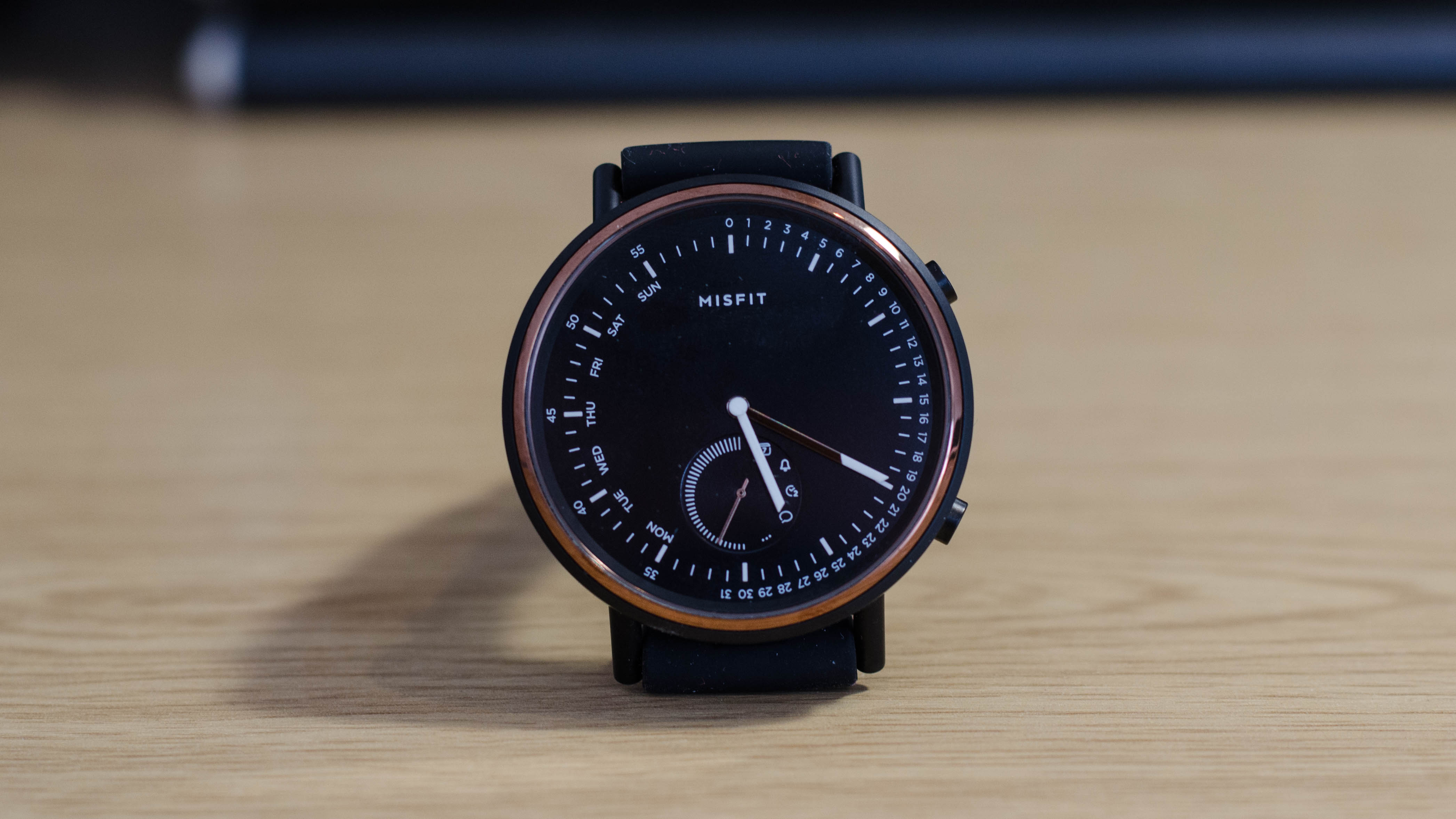TechRadar Verdict
A smarter watch rather than a smart watch, the Misfit Command is a subtle and stylish wearable with notifications, basic fitness tracking and a year-long battery life.
Pros
- +
Good looks
- +
One-year battery life
- +
Secondary button useful for music control
Cons
- -
Quick-release buckle causes discomfort
- -
Sleep tracking isn’t particularly useful
- -
No integrated heart rate monitor
Why you can trust TechRadar
Hybrid smartwatches tend to be for consumers who want a stylish wrist watch with months of battery life, but which can keep them up-to-date with calls, notifications on their phone and their daily activity.
The Misfit Command does exactly this but manages to cram slightly more information on its face than some of its simpler rivals. This is a hybrid smartwatch which retains more of the smarts of a ‘real’ smartwatch than some of the competition, but also manages to look like a regular watch.
You are alerted to calls and texts with a vibration - as is par for the course with all smartwatches these days - but a press of a button can also show you the day and date, the time of your alarm, and a second time zone of your choosing.
A second button can be configured to control music playback on your smartphone, operate your handset’s camera, or answer an incoming call.
Finally, the Misfit Command’s second dial shows how close you are to completing the day’s activity target, while the companion smartphone app gives a more detailed view of your daily exercise and sleep.

Misfit Command price and release date
- Price starts at £135 / $149.99 / AU$229.95
- Out now
There are four different versions of the Misfit Command. The one we are reviewing here is the matt black model with black rubber strap and copper details on the buckle, hands and case.
Misfit also sells a version which is fully black, and one which has a midnight blue rubber strap with rose gold highlights on the case and buckle. These all cost $149.99 / £135 / AU$229.95.
Finally, there is a matt silver version with a stainless steel bracelet, which costs more at $169.99 / £155 / AU$249.95.
The starting price then is slightly above the Nokia Steel for example, but slightly below the Garmin Vivomove HR.
We think all four options are attractive and will appeal to readers who want a watch with some smartness, but not so much that it starts to look like a gadget instead of a piece of jewelry or a fashion accessory.
If you fancy something more personal, all versions of the Command can be fitted with an industry-standard 20mm strap of your choice, and the buckle features a quick-release system, so it can be easily swapped.

Design
- Stylish and traditional face which is easy enough to read
- Nice range of color options, plus ability to fit any 20mm strap
- The latch can be uncomfortable against your wrist
While some hybrid smartwatches give little away on their face, instead opting to show you the meat of their capabilities via a smartphone app, the Misfit Command puts a lot on its face. At first, it feels like there is a little too much going on here and we found it took a day or so to get used to it.
There are the minute and hour hands, of course, which point to 12 subtle hour markers but are not illuminated. Their white tips help when telling the time at night, but in total darkness nothing on the Command’s face can be seen.
Between 12 o’clock and just after 6 o’clock are the numbers 1-31, to indicate the date, and from 7 o’clock to 11 o’clock are the days of the week.
A press of the upper of the watch’s two buttons causes the hour and minute hands to point to the day and date for a few seconds. It’s slower to read than a traditional date complication at 3 o’clock, but an interesting design quirk if nothing else.

Then there is the second dial, a common feature of hybrid smartwatches which is often used to show your daily steps or general activity. And that’s exactly the case here, too.
The slender hand of the second dial - finished in copper on our review unit to match the buckle and a ring around the glass - slowly works its way up from 6 o’clock to 12 as your daily ‘activity score’ grows from zero to the default total of 1,000. More on this later...
The other half of this second dial is split into icons representing other features. Press the upper button and the second hand will point to the date icon, while the hour and minute hands spin to the day and date.
Press the button again and, if you have an alarm set via the app, the second hand will point to the alarm icon, while the others show the time of your alarm. Press a third time and you’ll be shown your second time zone. Simple stuff, but executed well.
At 44mm, the Misfit Command’s case is slightly larger than your average men’s wristwatch, but it manages to not look or feel overly cumbersome, even on smaller wrists.

The case is approximately 15mm thick, which is on the chunky side for a hybrid watch, as opposed to a fully-fledged smartwatch, but the Command manages to get away with it. Perhaps years of smartwatch use has conditioned us to be more tolerant of larger wristwear, but we still think the Command hides its size well.
The case is metal, and although finished in a matt black that we thought would scratch easily, is remarkably resistant to showing any signs of wear and tear.
What we were less amused by, is how the quick-release latch on the buckle dug into the underneath of our wrist, making the watch a touch uncomfortable to wear. The latch is a sharp piece of metal which is raised to make sliding it (and thus removing the buckle) easy, but almost immediately after putting the Command on, it caused us problems.

It left a bit of a scratch on our skin which didn’t disappear after not wearing the Command overnight. We are left wondering how Misfit didn’t notice this before putting the Command into production; it just seems like such a glaringly obvious design flaw.
You could feasibly loosen the strap, but for a device designed in part to track fitness, this doesn’t seem ideal. Thankfully, fitting a different strap, or just switching out the quick-release bar for a regular one, would easily solve this.
Current page: Introduction, price and design
Next Page Fitness, battery life, interface and appAlistair Charlton is based in London and has worked as a freelance technology and automotive journalist for over a decade. A lifelong tech enthusiast, Alistair has written extensively about dash cams and robotic vacuum cleaners for TechRadar, among other products. As well as TechRadar, he also writes for Wired, T3, Forbes, The Independent, Digital Camera World and Grand Designs Magazine, among others.

